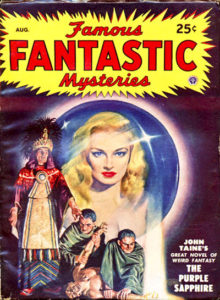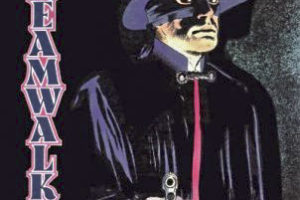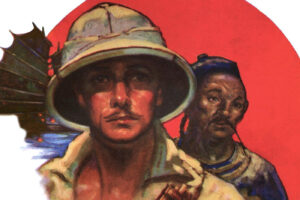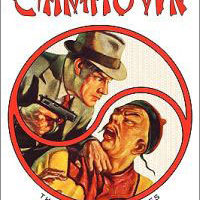 Scientists writing science fiction has been going on so since the genre started. But in the early years, some chose to use pseudonyms. One of the first was mathematician Eric Temple Bell (1883-1960) whose fiction appeared under the name John Taine.
Scientists writing science fiction has been going on so since the genre started. But in the early years, some chose to use pseudonyms. One of the first was mathematician Eric Temple Bell (1883-1960) whose fiction appeared under the name John Taine.
His first novel was The Purple Sapphire, a lost-race novel from 1927. It was later reprinted in Famous Fantastic Mysteries in 1948. I got the recent paperback edition from Armchair Fiction, which has this as number six in their “Lost World-Lost Race Classics” series, and used the cover from FFM, as well as interior artwork by Virgil Finley.
An interesting tale, it’s about the search for an English general’s daughter who had been kidnapped 12 years prior in India. She was 8-years-old at the time, and the general’s servant Singh seems the likely candidate. He was a somewhat mysterious figure who seems very knowledgeable in certain subjects. Very strange for a native servant. But years of searching by the British Secret Service turn up nothing about Evelyn.
But adding to the mystery is a large sapphire left behind by the servant in a metal box with unknown writing on it. The general reaches out to two people to search for his daughter: John Ford and his niece Rosita Rowe. They are American gem-hunters and explorers who are very knowledgeable about the wilds of Asia and the many different cultures and languages.
A third member to the party is Captain Joicey. He had been found delirious, babbling in an unknown language and clutching another large sapphire. The general surmises Joicey has been to the place that Evelyn has been taken. And perhaps if they can restore him from his delirium, he can help lead John and Rosita to that land.
Which he does. It turns out that an ancestor of his had met a traveler from that strange land and learned its story and wrote it all down. But no one read it until Joicey did and joined the British Indian Army to find it. It is a lost world, the remains of a lost civilization that had discovered a super-science beyond anyone else. Known as just the “Great Race”, this culture was advanced when the people of China were still in the Stone Age. Their land was in an inaccessible part of Tibet. Their science including being able to turn sandstone into sapphires by the use of some kind of mysterious ray.
But an accident long ago wiped out all in their culture that knew and understood their science, leaving a small number that have struggled on. Instead of trying to relearn their science, they instead have wasted time looking for the group of their people who left to form a new colony to the south. But such as group does not appear to still exist.
Now, the three will go on a perilous journey to find this lost world. Will they find riches? Will they be able to find Evelyn and return with her to civilization? Read and find out!
Taine has been criticized for being poor at characterization. The characters here are interesting. Rosita is not your delicate damsel in distress. She is smart and resourceful, fully capable of holding her own and willing to disguise herself as a native girl, made possible by her knowledge of the native languages. And she is very beautiful. Joicey is also a bit of a character. He comes off as a bit of a fop, but has a cunning mind. And strangely he has a monocle he wears at times in his left eye. He says he is nearly blind without it, but why not wear a pair of glasses? A monocle seems strange. But they make an interesting pair of pulp characters.
John Taine wrote several other science fiction works, some of which have been reprinted by Armchair Fiction. The Greatest Adventure is set in a lost world in Antarctica where dinosaurs still roam. I hope to read this one soon. Others they have reprinted include G.O.G. 666 and The Cosmic Geoids. He has other works that may be interesting to see brought back in print, and hope they will be. The Gold Tooth (1927) is another lost race story, this one set in Korea, and The Forbidden Garden (1947), is set in Tibet.




So Taine’s tale has a character named John Ford, huh? He probably never heard of the famed movie director of the same name who gave us such classics as “Stagecoach”, “The Searchers” and “The Quiet Man”.
The book was written in 1927. The director was not yet famous. Those movies came in the 30s and 40s…